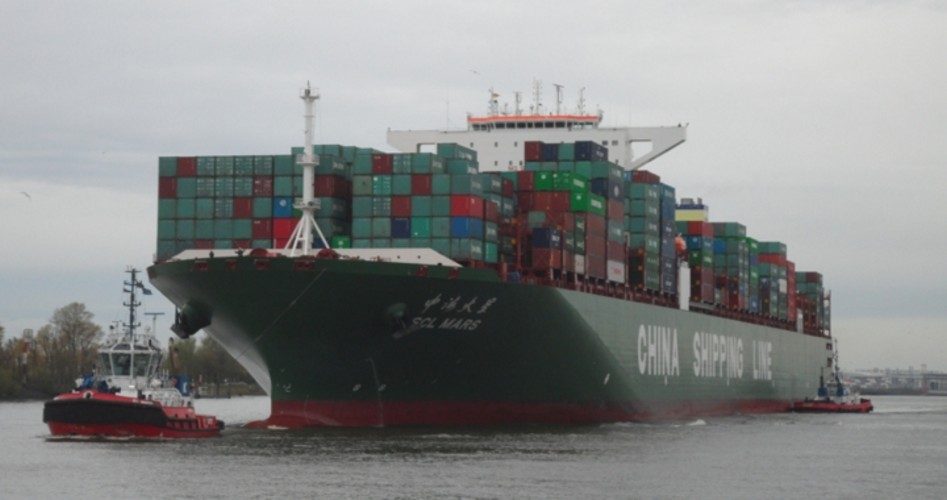
Two weeks ago the Shanghai Containerized Freight Index (SCFI), which tracks shipping rates from Shanghai to the world, fell off a cliff: down a breath-taking 67 percent from a year ago. Wolf Richter thought it was a statistical fluke.
It was no fluke. In the next two weeks the SCFI for Northern Europe fell another 14 percent, an all-time low. Wrote Richter: “Something big is going on in the China-Europe trade.”
The collapse is being echoed by other indexes reflecting the breathtaking decline in China’s exports. For example the much-broader China Containerized Freight Index (CCFI), despite being manipulated by the Chinese Ministry, has dropped from 1070 in February to 899 in April.
And the Baltic Dry Index, which tracks shipping rates for raw materials worldwide, shows a similar decline, from 1,484 in December to 575 on May 6.
Observers have come up with a long list of reasons why consumers aren’t buying: a weak and weakening euro, a topping out of demand from American companies building up their inventories anticipating a return of the American consumer to their stores, and weakness in China. Especially China whose purchasing managers’ report (PMI) released on May 1 was the worst reading since April 2005, a decade ago.
Bloomberg noted that China’s economy grew at the slowest rate in the first quarter of 2015 since the start of the Great Recession, despite claims by the Chinese government that its economy is still growing at seven percent annually. But most of that growth is phony and fraudulent, relying as it has for years on the Keynesian economic remedies to alleviate slow growth: expand the money supply, make borrowing easier, cut interest rates to goose the housing market, and “build for the future” such vanity investments as airports without planes, highways to nowhere, cities with no people, stadiums with no teams, and so on.
Now the chickens are coming home. Small business owners such as Zhu Zhangjin, the manager of a furniture factory which employs about 5,000 people and exports sofas and car seats to the United States, is having to borrow just to pay interest on previous loans he made to fund the business. But banks have been stiffed by so many other small businesses that they are reluctant to loan new money to people such as Zhu. If he can’t finance his debts, he won’t be shipping sofas to America. Multiply his company’s situation by millions and no one is surprised that shipping rates have dropped so precipitously.
China Merchants Bank Company has seen its bad debts more than double in the past year, while China Mensheng Banking Corporation, the country’s first private lender, saw its bad loans bloom by 140 percent in 2014 from a year earlier.
Chen Xingdong, chief economist at BNP Paribas, put it well:
[These] practices are simply not sustainable: you can’t tell banks to make risky loans with just political motivations [read: threats and pressure], banks won’t lend if returns can’t cover risks.
Fearful over the possible loss of purchasing power of the yuan, Chinese citizens with investable capital have been buying up fractional shares in apartment buildings erected in anticipation of massive migrations from the country into the city. Those apartments have remained empty, however.
Others with surplus capital have been bidding up the stock market, pushing the Shanghai index from 2,500 to 4,500 just since December. So much money has been pouring into stocks that it is starving the real economy, according to Xu Gao with Everbright Securities in Peking:
The stock market rally is actually an obstacle to an economic recovery. All the funds jostling into the stock market are diverting much-needed money from real economic activities.
The trouble is, those “real economic activities” have been stimulated to excessively high levels so that all that investors see are risks, not returns. Massive overcapacity in petrochemicals, construction machinery and equipment, steel, cement, and aluminum reflects the Keynesian solution: build something — anything! — and consumers and investors will follow.
Overcapacity in real estate in China is legendary: There are more than 50 million vacant units. But it’s even worse: Another 70 million units are currently being built, far exceeding even the most generous estimates of future demand. By comparison homebuilders in the United States in a good year build about 1.2 million homes.
As Anne Stevenson-Yang, for years an observer of China’s bubble and imminent collapse and now a research director for J Capital, noted in an interview with Barron’s:
China, for all its talk about economic reform, is in big trouble.… The country is now submerged by the tsunami of bad debt that begets further unhealthy credit growth to service this debt.
The perfect storm of excessive capacity in China funded with government debt combined with a weak euro is leading to the sharp falloff in exports as measured by the shipping indexes. There is nothing on the horizon to suggest that the end is anywhere in sight.
Photo of ship: hummelhummel
A graduate of an Ivy League school and a former investment advisor, Bob is a regular contributor to The New American magazine and blogs frequently at www.LightFromTheRight.com, primarily on economics and politics.



